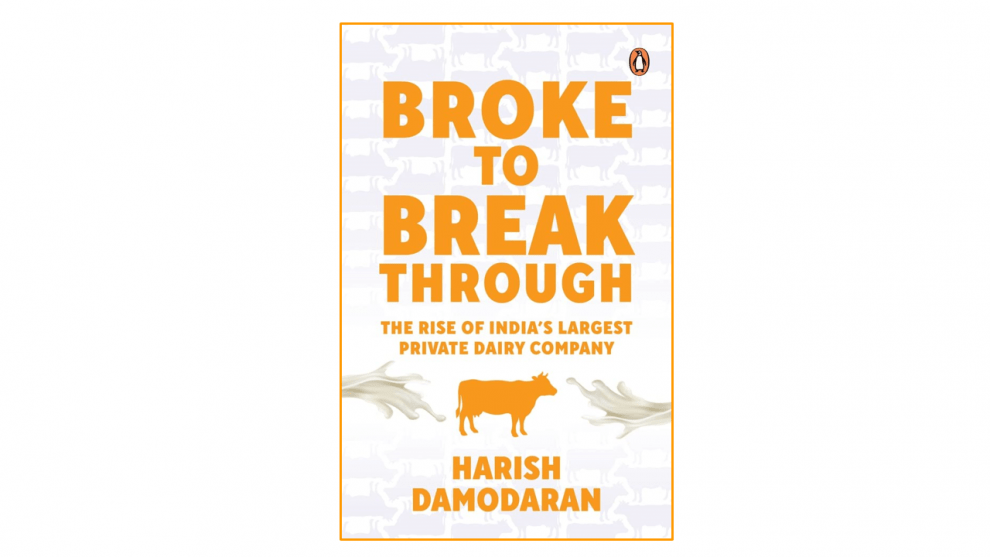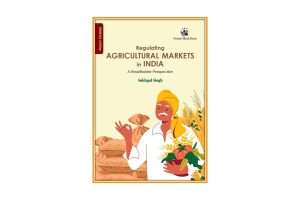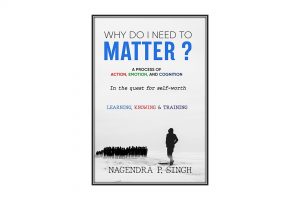Harish Damodaran 2021
Publisher: Viking
ISBN: 9780670095858
224 Pages
INR: ₹699.00
This book describes the way R.G. Chandramogan established Hatsun Agro product Limited (HAP), largest dairy company in India which is now procuring about 34 lakh litres from its 10,000 odd milk collection centres per day. It has 20 processing plants and supplies a wide range of milk and milk products to 42 countries. Harish Damodaran narrated in an interesting manner the entire five-decade journey of Chandramogan who started his business venture of manufacturing and selling ice candies in Madras (Chennai) in 1970 and now reached a stage that he was ranked as 100th richest man by Forbes India magazine in 2020.
A school dropout, Chandramogan in 1970 started his company with an ice candy unit at Royapuram, Madras (Chennai) to produce 10,000 candies per day. Later, he also established a small ice cream factory and started selling ice cream under the brand name ‘Arun’. Strategically he started supplying Arun Ice Cream to catering businesses by laying focus on students’ hostels in Madras, the market untapped by the established ice cream brands. In 1979, the first ice cream parlour was established at Royapuram and two years later the first ‘sit and eat’ Arun ice cream parlour was opened.
Realising the potential of the ice cream market, he modernized the ice cream factory by investing about Rs.70 lakh between 1983 and 1986 to handle 1000 litres of milk per day and to produce milk based ice cream. Arun Ice Cream parlours and sit and eat outlets came up in most towns in Tamil Nadu. In 1983 he also captured the ice cream market in Madras city which was dominated by famous brands like Dasaprakash, Kwality and Joy. He used his ingenuity in hiring little known celebrities at that time (now famous) and organised aggressive campaigns to establish Arun Ice Cream through Doordarshan commercials. He also conducted “two-wheeler slow races” and “Eat All You Can Ice Cream” melas besides introduced varieties like Cassata, Choco Crunch and Italian delight to beat the competitors who were supplying only plain vanilla and strawberry.
In 1986, he dissolved the old company and transferred all its assets to the newly formed Hatsun Foods Private Limited. Slowly, two factories were established in Tamil Nadu and the production capacity of the ice cream was increased to 15,000 litres per day. Slowly Arun ice cream was supplied to areas in and around Bangalore and few cities of Kerala. In all these centres, “ice cream supplied from Madras” was made a key selling point in advertisement banners and hoardings for Arun. Within a short span, 45 exclusive Arun Ice Cream outlets came up in Madras city and Arun Ice Cream became the market leader in Madras.
Reasons for Success
Chandramogan attributed three reasons for his success in the ice cream business: i) Change in the thinking that ice cream was only for city consumers; ii) Instead of selling the ice cream through retailers and provision stores, he established exclusive Arun Ice Cream Parlours and iii) using latest technologies like instant freezer equipment to prevent crystallization of water particles and ice flake formation and bactofugation, a better alternative to pasteurization in eliminating bacteria including spores. Quality-wise, Arun ice cream is 100 per cent milk based and free from crystallisation, is supplied through cold chain from production to consumer.
He promoted a unique franchise model by offering dealership to promising youngsters. These franchisees neither were given deep freezers to establish the parlours nor supplied ice cream on credit. This was a deviation from the prevailing market rules. By 1990, with a network of 170 franchisees in Tamil Nadu including Madras city, the company’s annual sales turnover touched Rs. 2.78 crore. Later, the company also launched Arun Ice Cream in Seychelles and Brunei as these two countries has a significant Tamil population. In 1991, another ice cream unit was commissioned in Salem and the required quantity of milk was procured from Nilgiri Dairy farm, local bulk vendors and also directly from the dairy farmers. Arun ice cream sales touched Rs. 10.97 crore by 1994-95. Encouraged by this performance a new factory was established at Nallur (TN) with a capacity to produce 15,000 litres of ice cream daily. In 1998, the previous two companies were merged and rechristened Hatsun Agro Product Limited (HAP). In 2000-01, the ice cream sales volume reached about 38 lakh litres and Arun continued to be in top position in Tamil Nadu.
In the nineties, there were very few private companies handling liquid milk in south India, those that dealt in very low volumes. In those days, Tamil Nadu Milk Producers’ Cooperative Federation was procuring about 13 lakh litres per day (LLPD) by collecting milk mostly from its primary milk cooperative societies. The Federation was supplying non homogenised toned milk (3.0% fat and 8.5% SNF) under the brand name ‘Aavin’ in cans at Rs.8 per litre. The management of Hatsun thought it was appropriate to enter into liquid milk market by supplying homogenised standardised milk (4.5% fat and 8.5% SNF) branded as ‘Arokya’ (health in Tamil) @ Rs.9 per litre in retail pouches to households. By the year 2000–2001, HAP was running three dairies and processing and selling about three LLPD of ‘Arokya’ standardised milk and ‘Komatha’ toned milk in addition to 38 lakh litres ice cream per year.
HAP started procuring milk from its own centres in 1988 and slowly it established its own collection centres. By 2015, it stopped purchasing milk through bulk vendors. HAP adopted the typical Anand pattern milk cooperative societies in villages. The first automatic Ekomilk Analyser/ Ekomilk Ultra Pro Analyser system (automatic milk testing unit) was installed in 2011 and later all the milk collection centres were equipped with Eko Milk Analysers, which Chandramogan consider as a game changer in his dairy business as it is a transparent method to procure milk from the farmers. The company also ensured payment to farmers at ten-day intervals for the milk procured. Later, it also resorted to payment to farmers through cashless transfers to their respective bank accounts, supply of cattle feed manufactured in their own feed mixing plants (Santosa) and providing breeding and veterinary health care services to the farmers. HAP also invested about Rs.200 crore in wind and solar power generation which helped in meeting about 60 per cent of the energy requirement of HAP units.
Demonetisation had little impact on HAP as it was the first to introduce cashless transfer to all its stakeholders, a practise that came handy when the central government announced demonetisation on 8 November 2016. Between 8 and 18 November 2016 HAP credited Rs. 64.25 crore to the accounts of 250,964 farmers for the milk supplied. The farmers were encouraged to grow fodder varieties such as hybrid napier to reduce the cost of milk production. The farmers started feeding more of green fodder and less of concentrates. Chandramogan believes that it is possible to realise the objective of doubling the farmers’ income not by increasing the procurement price but by minimising the cost of production through the application of appropriate technologies. This, he thinks, is necessary to compete in the international market.
HAP also set up an automated plastic film extrusion cum flexo printing plant with an investment of Rs. 63 crore to meet the company’s entire requirement of plastic pouches. The company also maintained its transparency in dealing with the farmers, be it milk testing or regular payment (unlike Aavin which has farmer’s dues pending up to three months and milk testing not being done in the presence of farmers leading to suspicions). Similarly, the company also ventured into advertisement of Arokya milk through a popular Tamil serial to enhance the credibility of the product among the consumers.
All these interventions helped the company in getting the entire quantity of milk required to feed its plants through its own assured milk collection centres. By 2019–2020 the average milk procurement of HAP was 27.26 LLPD from 381,456 farmers. HAP management was rather forced to lay focus on Arokya, its trusted brand. Chandramogan did not hesitate to seek expert advice from Al Ries (who co-authored a book on Positioning: the battle for your mind) although it involved quite a bit of money. At his request, Ries visited Chennai in 2003 and gave him a valuable suggestion to sell Arokya not as standardised milk (which many consumers do not understand and attach much significance) but as milk with 4.5% fat. Accordingly, ‘Arokya’ milk was sold as 4.5% or in Tamil Naalarai pal which attracted the attention of the consumers and the sales picked up.
The company management rightly recognised the potential of curd by targeting young married working women who have no time to set curd at home. Although ‘Komatha’ curd was introduced in 2001 and was supplied to households through retailers, the sales of curd were not encouraging and the company was forced to stop its production to minimise losses. The reason being that the retailers were unable to maintain cold chain leading to spoilages and losses. But Chandramohan did not hesitate to reintroduce curd as “Hatsun curd” which became the second biggest revenue source for the company after Arokya milk and on par with Arun ice cream.
In the year 2000, the company raised Rs.8.1 crores through public issue and the same were utilised to establish a dairy plant in Belgaum to supply ‘Arokya’ milk in northern districts of Karnataka and thereby avoiding competition with Karnataka Milk Producers’ Marketing Federation which was well entrenched in supplying liquid milk (brand Nandini) in southern Karnataka. In the same year, HAP acquired Ajith Dairy Industries Ltd. (ADL) in Kanchipuram (TN) and expanded its capacity to 1,75,000 litres per day with Milk and Milk Product Order (1992) approval. The total expansion plan was executed with an investment of Rs. 22 crores, much of which was raised through loans from ICICI bank. By the end of 2000–2001, HAP was managing three dairies selling an average 3,00,000 litres per day of liquid milk; Arun ice cream retained its leadership in TN although Hindustan Lever was selling its brand Kwality ice cream.
By 2020-21, HAP was operating two ice cream plants and 12 dairies (eight in TN, two in Karnataka, one in AP and one in Telangana) handling about 50 LLPD. Later, two more dairies (one in Maharashtra and one in TN) were added with a capacity to handle another 9 LLPD. Another ice cream plant with an investment of Rs. 311 crore is expected to be commissioned in 2022.
Bracing challenges
The five-decade journey of Chandramogan was not without hurdles. He faced several challenges and learnt lessons from them. Although he erred, he boldly took appropriate decisions like seeking advice from the right persons in the trade, timely withdrawal from non-performing projects, acquiring old dairies, restructuring of the market networks, forward and backward linkages, etc.
A noteworthy lesson for Chandramogan was in 1992 when he tried to replicate the success of Rasna, a popular soft drink by producing Santosa instant milk shake powder. The consumer has to reconstitute it with water and churn it with ice cubes in a blender to get milkshake. This product launched with an investment of Rs. 2 crore was failed as women did not appreciate the idea of churning ice cubes in a blender as they feared it may hurt the machine’s blades.
During 1993-95, the company incurred a loss of Rs. 4 to 4.5 lakhs every month. Then Chandramogan sought advice from Jimmy Rana, the owner of Dinshaw’s Dairy Foods Private Ltd., who suggested him to enter into liquid milk business which was not in his dream. Another misadventure was his diversification into sale of pulses (dal) under the brand name “Apurva” in 1998 which Chandramogan had to close a couple of years after its introduction. The huge turnaround in dairy business rather forced him to wind up dal division and focus on dairy and ice cream.
Lockdown hit the ice cream business very hard resulting in heavy losses. HAP was no exception. For the first time, the company registered negative sales growth of more than 10%. But the company management handled the lockdown situation by i) stocking critical inputs like fuel, water, packing materials, etc. ii) collecting milk from farmers through differential rates of payment based on their loyalty to the company (regular supplier or otherwise), iii) introducing “essential service allowance” to the employees involved in essential activities, iv) retaining all the redundant workforce, etc. HAP recovered from this loss and recorded highest-ever profits. Chandramogan attributed this success to the company’s core strength in looking for opportunities in crises.
The company was emboldened to face the crisis by its past experiences: i) during the railway bridge collapse in Madras in 1985 the company resorted to taking circuitous route to reach consumers; ii) when there was a short supply of dry ice, the company imported dry ice from Singapore without passing the extra cost to the consumers and iii) when a tsunami hit the TN coast in 2004, the company took pain in supplying milk to people in the worst-hit areas of Nagapattinam and Cuddlaore.
Drawing inspiration
Chandramogan derived inspiration from several people. Notable among them were
- his school teacher, PK Srinivasan, who inspired him to aim at becoming a professional instead of working in menial jobs;
- his business role models P Ayya Nadar and A Shanmuga Nadar who pioneered in establishing manufacturing units of safety matches, fireworks and printing in Sivakasi which eventually turned out to be a “mini Japan”;
- his grandmother from whom he learnt the first management lesson of conserving natural resources. He recollects her words in Tamil which in English mean “water is like gold, not a drop should be wasted”.
The author of this book could have included the latest procurement and consumer prices for Arokya milk (4.5 % fat and 8.5% SNF) to know the producer’s share in consumer rupee; cost of cattle feed to the farmer and the average annual supply of feed to the farmers; number of veterinarians and para veterinarians delivering the breeding and veterinary services, which the farmers value the most etc. It is my general observation that the dairy farmers shift their loyalty from one dairy to the other and vice-versa while pouring milk and I am sure HAP also must be experiencing this phenomenon. The dairy farmers in many states, except probably in Gujarat, are exploited by dairies irrespective of their type of management (cooperative or private or producers’ company). In reality, the dairy farmers pay for all (stakeholders) and they bear the brunt of all “ifs and buts”.
To me, it appears that HAP focussed on investing profits on expansion and achieving supremacy in dairy business and it succeeded to a great extent. But all is not well at HAP, as can be seen from a recent press report. “Amid the celebration of the founder’s success story (a business biography titled Broke to Breakthrough was published in September,) and the massive investment, HAP’s 10,000 permanent and 22,000 contractual employees in Tamil Nadu alone have little to celebrate. They complain of forced resignations and transfers, underpayment and overwork, and inhuman treatment by superiors. Frustrated and angry, the employees of the Kolasanahalli plant, in Dharmapuri city, formed a trade union a few months ago to protest the “inhuman treatment” and other problems” (Source: https://www.newsclick.in/milk-largest-private-dairy-company-turns-sour-workers. Accessed on 6th Nov, 2021).
This book contains rich and vast experience of Chandramogan that will be of immense value to those who wish to become entrepreneurs in agriculture and allied sectors. I recommend this book for the students and staff of agriculture, veterinary, dairy and fisheries science colleges.
Dr SVN Rao
 Dr SVN Rao retired as Professor and Head, Department of Veterinary and Animal Husbandry Extension Education, Rajiv Gandhi Institute of Veterinary Education and Research (RIVER), Puducherry. He can be contacted at: svnrao1953@gmail.com
Dr SVN Rao retired as Professor and Head, Department of Veterinary and Animal Husbandry Extension Education, Rajiv Gandhi Institute of Veterinary Education and Research (RIVER), Puducherry. He can be contacted at: svnrao1953@gmail.com





Chandramogan’s achievements are incredible and so much inspiring that success is certain if you have patience, sincerity and attitude to adopt suggestions and learn from mistakes. Dr Rao’s review on the Book is as usual very professional and highly appreciative. It can motivate everyone to read the book, know more about Chandramogan’s journey in attaining celebrity in business and emerging signs of discontent among those who were behind in building the empire. But I am sure Chandramogan will address these signs of adversity also into advantage soon by sorting out problems to the satisfaction of all. Congratulations to Chandramogan, the Hero of the success story, Harish Damodaran the author of the success story and Dr.SVN Rao the reviewer of the Book and above all AESA for publishing the Book Review.